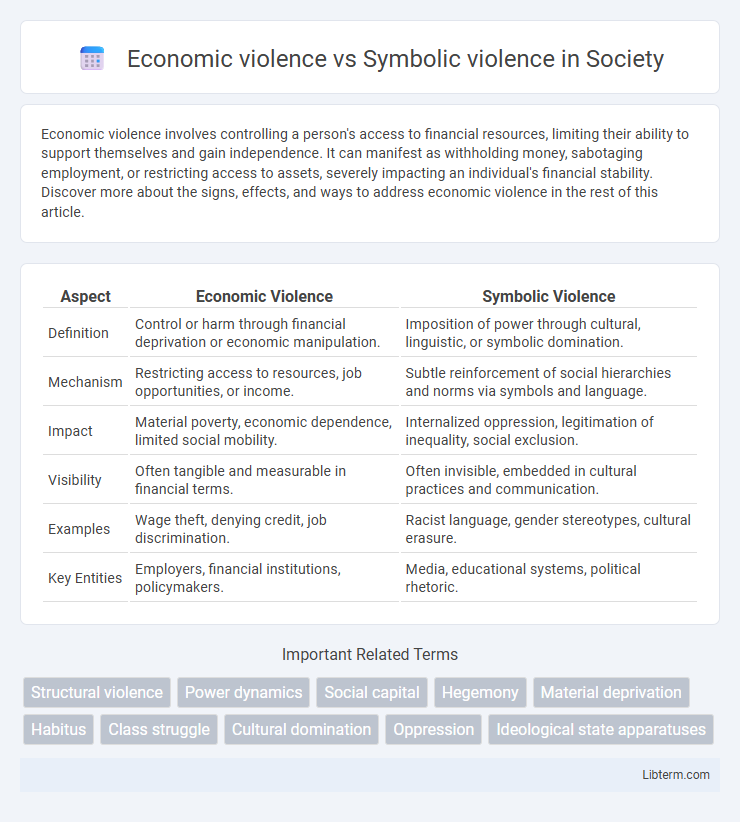Economic violence involves controlling a person's access to financial resources, limiting their ability to support themselves and gain independence. It can manifest as withholding money, sabotaging employment, or restricting access to assets, severely impacting an individual's financial stability. Discover more about the signs, effects, and ways to address economic violence in the rest of this article.
Table of Comparison
| Aspect | Economic Violence | Symbolic Violence |
|---|---|---|
| Definition | Control or harm through financial deprivation or economic manipulation. | Imposition of power through cultural, linguistic, or symbolic domination. |
| Mechanism | Restricting access to resources, job opportunities, or income. | Subtle reinforcement of social hierarchies and norms via symbols and language. |
| Impact | Material poverty, economic dependence, limited social mobility. | Internalized oppression, legitimation of inequality, social exclusion. |
| Visibility | Often tangible and measurable in financial terms. | Often invisible, embedded in cultural practices and communication. |
| Examples | Wage theft, denying credit, job discrimination. | Racist language, gender stereotypes, cultural erasure. |
| Key Entities | Employers, financial institutions, policymakers. | Media, educational systems, political rhetoric. |
Understanding Economic Violence
Economic violence involves deliberate actions that harm an individual's financial stability, such as controlling access to income, employment, or resources, effectively limiting economic independence. It manifests through practices like wage theft, withholding financial support, or sabotaging work opportunities, often reinforcing systemic inequalities. Understanding economic violence requires recognizing its impact on autonomy and well-being, as well as its role in perpetuating poverty and social exclusion.
Defining Symbolic Violence
Symbolic violence refers to the subtle, often invisible forms of dominance and power exercised through cultural symbols, language, and social norms that perpetuate inequality without physical force. It operates by shaping perceptions, legitimizing social hierarchies, and internalizing oppression, which distinguishes it from economic violence characterized by direct financial control or deprivation. This concept, developed by sociologist Pierre Bourdieu, highlights how symbolic power influences social structures and individual behaviors, reinforcing systemic inequality.
Historical Contexts of Economic and Symbolic Violence
Economic violence manifests through systemic exploitation and resource deprivation, deeply rooted in colonial histories and capitalist structures that marginalize vulnerable populations. Symbolic violence operates through cultural domination and internalized oppression, shaped by historical power relations that legitimize social hierarchies and cultural discrimination. Both forms intertwine historically, reinforcing oppressive systems that perpetuate inequality across social, economic, and political domains.
Key Differences Between Economic and Symbolic Violence
Economic violence involves the deliberate deprivation of financial resources, access to employment, or control over assets, directly impacting an individual's material well-being and independence. Symbolic violence, on the other hand, refers to the subtle imposition of power through language, norms, and cultural practices that reinforce social hierarchies and marginalize specific groups without overt physical or financial harm. Key differences lie in the tangible material consequences of economic violence compared to the intangible, psychological and social domination embedded in symbolic violence.
Common Manifestations in Society
Economic violence manifests through wage theft, unemployment discrimination, and exploitation in labor markets, severely limiting individuals' financial independence and access to resources. Symbolic violence appears in social norms, language, and media that perpetuate stereotypes, marginalizing certain groups and legitimizing unequal power structures. Both forms operate subtly yet pervasively, reinforcing systemic inequalities and social hierarchies.
Impact on Marginalized Communities
Economic violence restricts marginalized communities' access to essential resources like employment, housing, and healthcare, perpetuating poverty and deepening social inequality. Symbolic violence manifests through cultural domination and internalized inferiority, undermining self-worth and social cohesion among these groups. Both forms reinforce systemic barriers, hindering marginalized populations' opportunities for economic mobility and social empowerment.
Institutional Roles in Perpetuating Violence
Economic violence manifests through institutional mechanisms like wage disparities, employment discrimination, and resource withholding that systematically disadvantage marginalized groups, reinforcing socio-economic inequalities. Symbolic violence operates via cultural norms and practices embedded within institutions such as education and media, perpetuating domination by legitimizing unequal power relations through language, symbols, and ideology. Both forms of violence are perpetuated by institutional roles that normalize exclusion and invisibility, sustaining systemic oppression beyond physical or overt actions.
Intersections: When Economic Meets Symbolic Violence
Economic violence involves the control or deprivation of financial resources to limit an individual's autonomy, while symbolic violence operates through cultural dominance and subtle social coercion that enforces power structures. Intersections emerge when economic constraints are reinforced by symbolic means, such as stigma and normalized gender roles, exacerbating marginalization and perpetuating systemic inequality. Understanding these overlaps highlights how financial abuse and cultural oppression jointly sustain exclusion in contexts like domestic settings and labor markets.
Strategies for Addressing Both Forms of Violence
Strategies for addressing economic violence involve implementing policies that ensure fair wages, access to financial resources, and social safety nets to reduce economic dependence and exploitation. Tackling symbolic violence requires promoting critical consciousness, inclusive education, and media literacy to challenge dominant cultural norms and power relations that perpetuate inequality. Integrating community-based interventions with legal reforms enhances resilience against both economic and symbolic violence by empowering marginalized groups and transforming systemic structures.
Toward Social Change: Breaking Cycles of Violence
Economic violence undermines individuals' financial stability and perpetuates dependency, reinforcing systemic inequalities that hinder social mobility. Symbolic violence, manifested through cultural norms and language, legitimizes and naturalizes these power imbalances, making discriminatory practices less visible. Breaking cycles of violence requires addressing both material deprivation and the symbolic frameworks that sustain social hierarchies, enabling transformative social change and empowerment.
Economic violence Infographic

 libterm.com
libterm.com